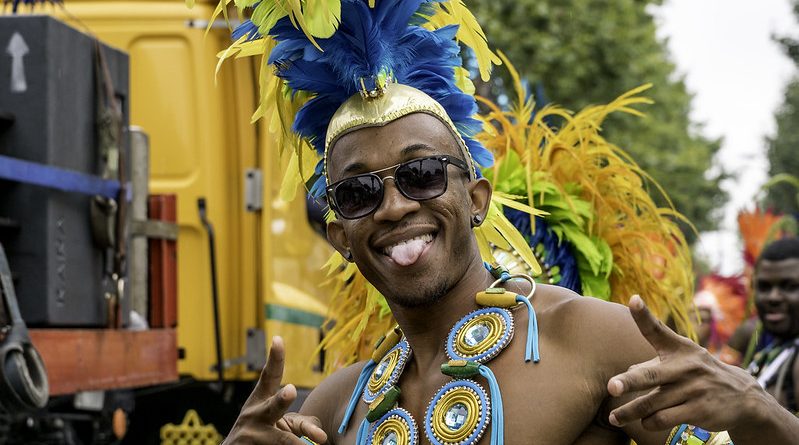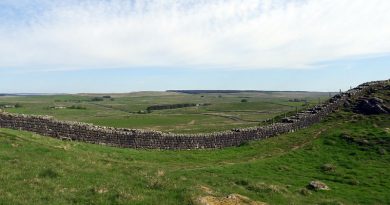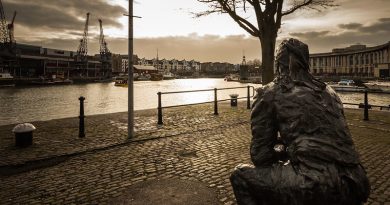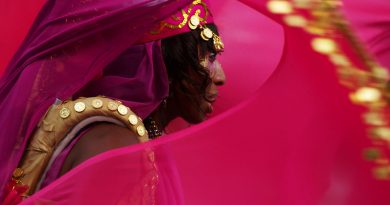My Notting Hill, My Carnival
Founded in 1959, only 100 years after slavery was abolished in the USA, the first Carnival showcased was a cabaret style showcase of the steel bands performing around London each weekend. It is now a hub for people all over the world wanting to experience the vibrancy of Caribbean culture and the all glorious madness of London life.
Notting Hill Carnival parade participant
My Carnival Life
My first memory of Notting Hill Carnival is from 1995. I was five years old, had flowers painted on my face to match my favourite dress. It was my first memory of being there, though I had been already been a regular carnival-goer for the past four years. My mother recounts the story of sitting me on her lap, aged 8 months, outside of our flat on Lancaster Road to experience what would be the first of 25 carnivals, and counting.
Mid-August, Ladbroke Grove and Notting Hill begins to buzz with an energetic air that emanates the vibrations ‘Carnival is coming!’ Local shops and restaurants are boarded up and sales of Jamaica’s famous lager Red Stripe soar, the community I have grown up in prepares for our favourite time of year.
For me, Carnival, is more than a bank holiday spent dancing the sun (sometimes!) – it’s a celebration of my Bajan & Montserratian Roots, in my favourite city in the world. My blood is Caribbean and Scandinavian but I’m British through and through. London is my home and to have a space to commemorate all of my ancestries and histories over two days fills me with such pride. It’s a display of unity, strength and freedom. No matter how far I travel, and how many incredible festivals I go to, I’m always sure to be home for Carnival, there is simply nothing as great.
Held every August over the bank holiday weekend, Notting Hill Carnival is the annual celebration of Afro-Caribbean communities in London, though people come from all over the country, Europe and in fact the world over. Led by the British West Indian community, the Carnival is Europe’s biggest street party, attracting over 1 million people over the two-day event.
Some History
At the roots of the Notting Hill Carnival are the Caribbean carnivals of the early 19th century – a particularly strong tradition in Trinidad – all about celebrating the abolition of slavery and the slave trade.
And whilst Carnival’s ethos was stamped with these roots from the outset, its formulation in the mid-1960s came from two separate but interconnected strands.
A “Caribbean Carnival” was held on 30 January 1959 in St Pancras Town Hall as a response to the problematic state of race relations at the time; the UK’s first widespread racial attacks, the Notting Hill race riots in which 108 people were charged, had occurred the previous year. The 1959 event, held indoors and televised by the BBC, was organised by the Trinidadian Claudia Jones, often described as “the mother of the Notting Hill Carnival”, in her capacity as editor of Britain’s first black newspaper The West Indian Gazette, and directed by Edric Connor; showcased elements of a Caribbean carnival in a cabaret style format, it “featured among other things the Mighty Terror singing the calypso ‘Carnival at St Pancras’, a Caribbean Carnival Queen beauty contest, the Trinidad All Stars and Hi–fi steel bands dance troupe and a Grand Finale Jump-Up by West Indians who attended the event ,” as quoted in the “About us”, Notting Hill Carnival ’13, London Notting Hill Enterprises Trust.
The other important strand was the “hippie” London Free School-inspired festival in Notting Hill that became the first organised outside event in August 1966. The key instigater was Rhaune Laslett, who was not aware of the indoor events when she first raised the idea. This festival was a more diverse Notting Hill event to promote cultural unity. A street party for neighbourhood children turned into a carnival procession when Russell Henderson’s steel band (who had played at the earlier Claudia Jones events) went on a walkabout. By 1970 Carnival consisted of 2 music bands, the Russell Henderson Combo and Selwyn Baptiste’s Notting Hill Adventure Playground Steelband and 500 people in attendance.
Moving on to how Carnival came to take the shape in the way it known today, we meet a young teacher, Leslie Palmer, who first organised Carnival as a major festival in 1975. He was the Official Director of the event between 1973 and 1975 and is credited with negotiating sponsors, recruiting more steel bands, reggae and ragga sound systems, introducing generators and extended the Carnival route. She also encouraged traditional costume, and for the first time in 1975 costumed dancers and musicians and steel bands hailing from all across the Caribbean Islands took part in the street party riding on floats alongside the brand-new stationary sound systems.
By this time, the event had Caribbean flavours running deeply through it’s veins, attracting 150,000 people. And as Carnival grew it was marred by violent interactions with the police and subsequent rioting. The problems appeared to only escalate and it seemed as likely the event was on course to be banned.
However in recent years, with the installation of more CCTV cameras in the area, better flow management and the deployment of thousands of Metropolitan Police Officers patrolling the street with a more conciliatory attitude to policing, the event has been affected by less violence and trouble and attention is back with the revelry.
As of 2003 the Carnival has been run by ‘The Notting Hill Carnival Trust Ltd’. Whilst the Carnival has come under scrutiny for its cost to the London taxpayer (the cost of policing the event is said to be over £7 million), it is estimated that the Carnival contributes over £100 million to the London & UK economy – even Prince Charles is a vocal supporter of the event!
Notting Hill Carnival crowds
Carnival Today
Today Carnival is expression, culture, unity and pride; a celebration not only of Afro-Caribbean communities in the UK but a celebration of their place in British society. Yet, it’s also a celebration of us all! Everyone is welcome, and encouraged to come with an open mind and comfortable shoes.
Reggae, ragga, dancehall, soca, bashment and house music fill every street, alley way and square of Ladbroke Grove, Notting Hill and Westbourne Park from the morning until the summer sun sets with Carnival finishing this year at 8.30pm.
For the authentic Carnival experience, there’s nothing like a can of Jamaican lager and a box of freshly barbequed jerk chicken, rice and peas. The procession this year will begin at the top of Great Western Road, follow the floats and vibrant costumes along turning onto Westbourne Park Road to experience some of the best stationary sound systems that Carnival has to offer and meet the floats back on Ladbroke Grove for the rest of the procession.
Sunday is ‘A Family Day’, fewer crowds are in attendance crowd than the Monday, and families dressed head to toe in Caribbean inspired colours, with face painting happening all over the event. Monday is ‘The Grand Finale’, also known as adult’s day when the crowds are bigger, tunes are louder and the dancing gets sexier.
Whichever day you decide to go, the welcoming, warm and wonderful hub of this street party’s energy, music and people bathing in the diversity and madness that is Notting Hill Carnival will forever have a place in your heart.
For more on the history look here: http://www.thelondonnottinghillcarnival.com/carnival.html
For info on transport and maps + schedules: http://www.timeout.com/london/things-to-do/notting-hill-carnival-guide
Further references: https://en.wikipedia.org/wiki/Notting_Hill_Carnival#cite_ref-Younge_2002_12-0
* * *
Written by Tasha Brade who is Office Manager at Pilot Productions HQ here in London
You can check out her blog on life as a Londoner here: http://www.lifeblog.org/




